Christo Kurisummoottil Thomas
Flexible Semantic-Aware Resource Allocation: Serving More Users Through Similarity Range Constraints
Apr 29, 2025Abstract:Semantic communication (SemCom) aims to enhance the resource efficiency of next-generation networks by transmitting the underlying meaning of messages, focusing on information relevant to the end user. Existing literature on SemCom primarily emphasizes learning the encoder and decoder through end-to-end deep learning frameworks, with the objective of minimizing a task-specific semantic loss function. Beyond its influence on the physical and application layer design, semantic variability across users in multi-user systems enables the design of resource allocation schemes that incorporate user-specific semantic requirements. To this end, \emph{a semantic-aware resource allocation} scheme is proposed with the objective of maximizing transmission and semantic reliability, ultimately increasing the number of users whose semantic requirements are met. The resulting resource allocation problem is a non-convex mixed-integer nonlinear program (MINLP), which is known to be NP-hard. To make the problem tractable, it is decomposed into a set of sub-problems, each of which is efficiently solved via geometric programming techniques. Finally, simulations demonstrate that the proposed method improves user satisfaction by up to $17.1\%$ compared to state of the art methods based on quality of experience-aware SemCom methods.
Large-Scale AI in Telecom: Charting the Roadmap for Innovation, Scalability, and Enhanced Digital Experiences
Mar 06, 2025Abstract:This white paper discusses the role of large-scale AI in the telecommunications industry, with a specific focus on the potential of generative AI to revolutionize network functions and user experiences, especially in the context of 6G systems. It highlights the development and deployment of Large Telecom Models (LTMs), which are tailored AI models designed to address the complex challenges faced by modern telecom networks. The paper covers a wide range of topics, from the architecture and deployment strategies of LTMs to their applications in network management, resource allocation, and optimization. It also explores the regulatory, ethical, and standardization considerations for LTMs, offering insights into their future integration into telecom infrastructure. The goal is to provide a comprehensive roadmap for the adoption of LTMs to enhance scalability, performance, and user-centric innovation in telecom networks.
Joint Holographic Beamforming and User Scheduling with Individual QoS Constraints
Feb 24, 2025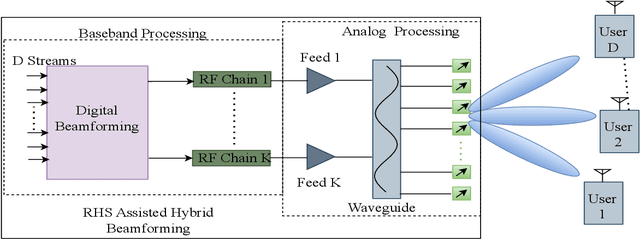
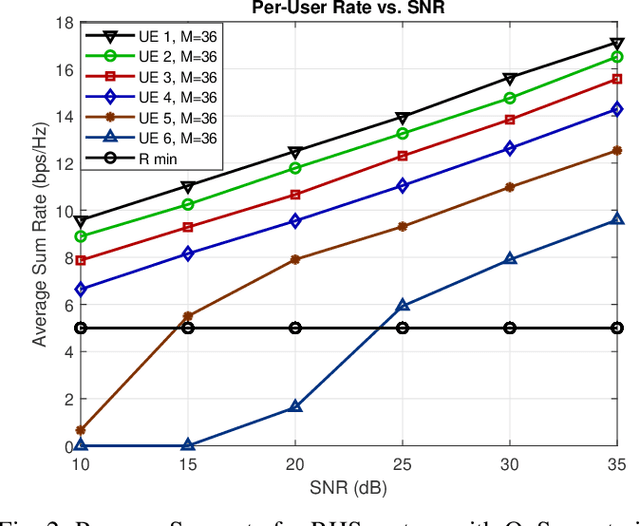
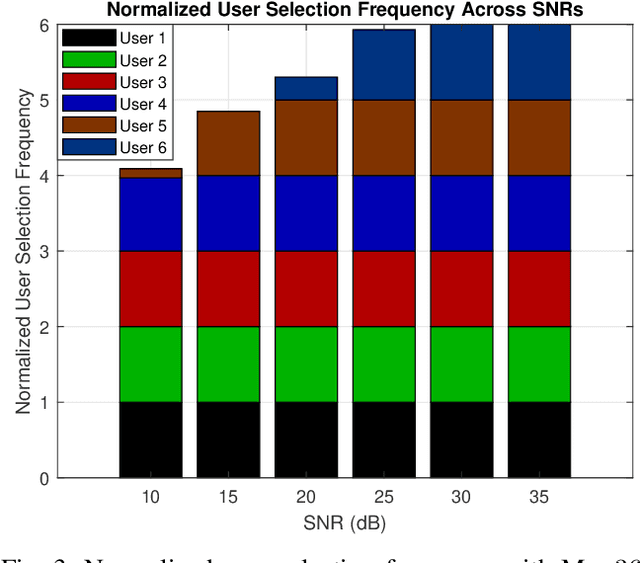
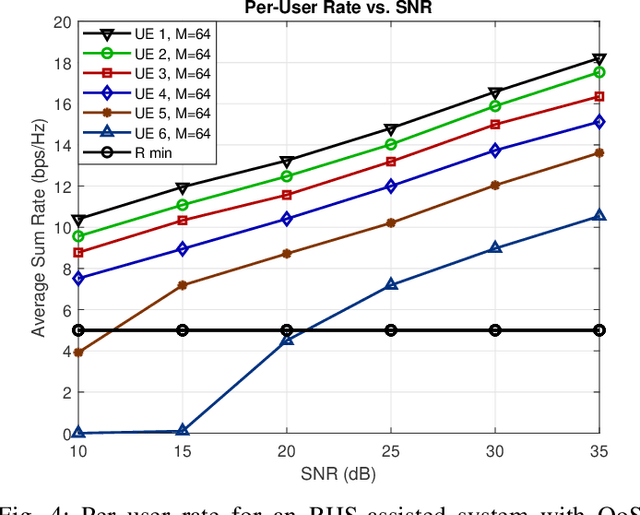
Abstract:Reconfigurable holographic surfaces (RHS) have emerged as a transformative material technology, enabling dynamic control of electromagnetic waves to generate versatile holographic beam patterns. This paper addresses the problem of joint hybrid holographic beamforming and user scheduling under per-user minimum quality-of-service (QoS) constraints, a critical challenge in resource-constrained networks. However, such a problem results in mixed-integer non-convex optimization, making it difficult to identify feasible solutions efficiently. To overcome this challenge, we propose a novel iterative optimization framework that jointly solves the problem to maximize the RHS-assisted network sum-rate, efficiently managing holographic beamforming patterns, dynamically scheduling users, and ensuring the minimum QoS requirements for each scheduled user. The proposed framework relies on zero-forcing digital beamforming, gradient-ascent-based holographic beamformer optimization, and a greedy user selection principle. Our extensive simulation results validate the effectiveness of the proposed scheme, demonstrating their superior performance compared to the benchmark algorithms in terms of sum-rate performance, while meeting the minimum per-user QoS constraints
Joint Beamforming and 3D Location Optimization for Multi-User Holographic UAV Communications
Feb 24, 2025Abstract:This paper pioneers the field of multi-user holographic unmanned aerial vehicle (UAV) communications, laying a solid foundation for future innovations in next-generation aerial wireless networks. The study focuses on the challenging problem of jointly optimizing hybrid holographic beamforming and 3D UAV positioning in scenarios where the UAV is equipped with a reconfigurable holographic surface (RHS) instead of conventional phased array antennas. Using the unique capabilities of RHSs, the system dynamically adjusts both the position of the UAV and its hybrid beamforming properties to maximize the sum rate of the network. To address this complex optimization problem, we propose an iterative algorithm combining zero-forcing digital beamforming and a gradient ascent approach for the holographic patterns and the 3D position optimization, while ensuring practical feasibility constraints. The algorithm is designed to effectively balance the trade-offs between power, beamforming, and UAV trajectory constraints, enabling adaptive and efficient communications, while assuring a monotonic increase in the sum-rate performance. Our numerical investigations demonstrate that the significant performance improvements with the proposed approach over the benchmark methods, showcasing enhanced sum rate and system adaptability under varying conditions.
Hypergame Theory for Decentralized Resource Allocation in Multi-user Semantic Communications
Sep 26, 2024


Abstract:Semantic communications (SC) is an emerging communication paradigm in which wireless devices can send only relevant information from a source of data while relying on computing resources to regenerate missing data points. However, the design of a multi-user SC system becomes more challenging because of the computing and communication overhead required for coordination. Existing solutions for learning the semantic language and performing resource allocation often fail to capture the computing and communication tradeoffs involved in multiuser SC. To address this gap, a novel framework for decentralized computing and communication resource allocation in multiuser SC systems is proposed. The challenge of efficiently allocating communication and computing resources (for reasoning) in a decentralized manner to maximize the quality of task experience for the end users is addressed through the application of Stackelberg hyper game theory. Leveraging the concept of second-level hyper games, novel analytical formulations are developed to model misperceptions of the users about each other's communication and control strategies. Further, equilibrium analysis of the learned resource allocation protocols examines the convergence of the computing and communication strategies to a local Stackelberg equilibria, considering misperceptions. Simulation results show that the proposed Stackelberg hyper game results in efficient usage of communication and computing resources while maintaining a high quality of experience for the users compared to state-of-the-art that does not account for the misperceptions.
Semantic Communication for the Internet of Sounds: Architecture, Design Principles, and Challenges
Jul 16, 2024



Abstract:The Internet of Sounds (IoS) combines sound sensing, processing, and transmission techniques, enabling collaboration among diverse sound devices. To achieve perceptual quality of sound synchronization in the IoS, it is necessary to precisely synchronize three critical factors: sound quality, timing, and behavior control. However, conventional bit-oriented communication, which focuses on bit reproduction, may not be able to fulfill these synchronization requirements under dynamic channel conditions. One promising approach to address the synchronization challenges of the IoS is through the use of semantic communication (SC) that can capture and leverage the logical relationships in its source data. Consequently, in this paper, we propose an IoS-centric SC framework with a transceiver design. The designed encoder extracts semantic information from diverse sources and transmits it to IoS listeners. It can also distill important semantic information to reduce transmission latency for timing synchronization. At the receiver's end, the decoder employs context- and knowledge-based reasoning techniques to reconstruct and integrate sounds, which achieves sound quality synchronization across diverse communication environments. Moreover, by periodically sharing knowledge, SC models of IoS devices can be updated to optimize their synchronization behavior. Finally, we explore several open issues on mathematical models, resource allocation, and cross-layer protocols.
Artificial General Intelligence (AGI)-Native Wireless Systems: A Journey Beyond 6G
Apr 29, 2024



Abstract:Building future wireless systems that support services like digital twins (DTs) is challenging to achieve through advances to conventional technologies like meta-surfaces. While artificial intelligence (AI)-native networks promise to overcome some limitations of wireless technologies, developments still rely on AI tools like neural networks. Such tools struggle to cope with the non-trivial challenges of the network environment and the growing demands of emerging use cases. In this paper, we revisit the concept of AI-native wireless systems, equipping them with the common sense necessary to transform them into artificial general intelligence (AGI)-native systems. These systems acquire common sense by exploiting different cognitive abilities such as perception, analogy, and reasoning, that enable them to generalize and deal with unforeseen scenarios. Towards developing the components of such a system, we start by showing how the perception module can be built through abstracting real-world elements into generalizable representations. These representations are then used to create a world model, founded on principles of causality and hyper-dimensional (HD) computing, that aligns with intuitive physics and enables analogical reasoning, that define common sense. Then, we explain how methods such as integrated information theory play a role in the proposed intent-driven and objective-driven planning methods that maneuver the AGI-native network to take actions. Next, we discuss how an AGI-native network can enable use cases related to human and autonomous agents: a) analogical reasoning for next-generation DTs, b) synchronized and resilient experiences for cognitive avatars, and c) brain-level metaverse experiences like holographic teleportation. Finally, we conclude with a set of recommendations to build AGI-native systems. Ultimately, we envision this paper as a roadmap for the beyond 6G era.
Large Multi-Modal Models (LMMs) as Universal Foundation Models for AI-Native Wireless Systems
Feb 07, 2024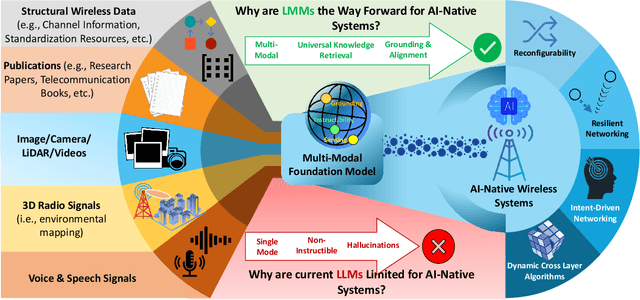
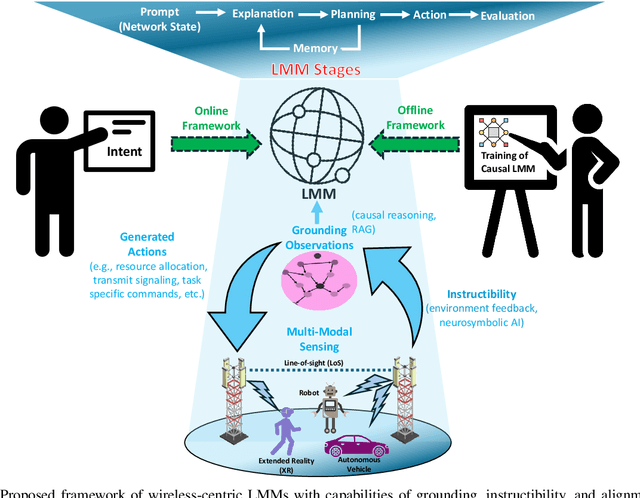
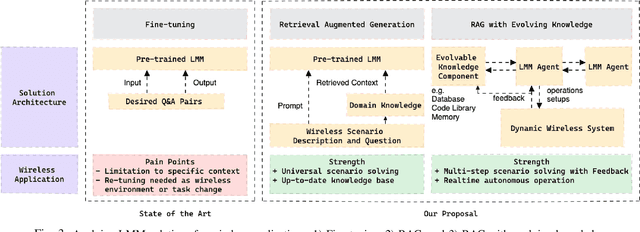
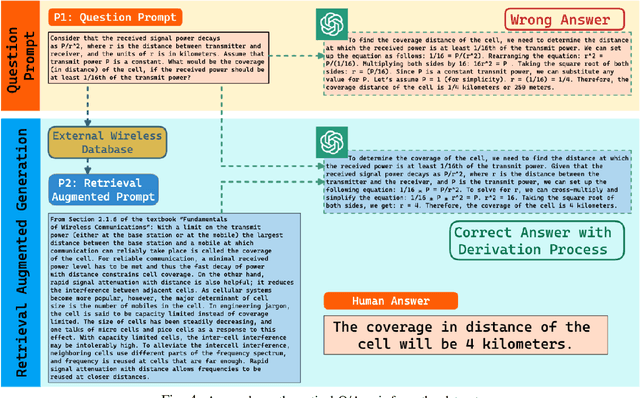
Abstract:Large language models (LLMs) and foundation models have been recently touted as a game-changer for 6G systems. However, recent efforts on LLMs for wireless networks are limited to a direct application of existing language models that were designed for natural language processing (NLP) applications. To address this challenge and create wireless-centric foundation models, this paper presents a comprehensive vision on how to design universal foundation models that are tailored towards the deployment of artificial intelligence (AI)-native networks. Diverging from NLP-based foundation models, the proposed framework promotes the design of large multi-modal models (LMMs) fostered by three key capabilities: 1) processing of multi-modal sensing data, 2) grounding of physical symbol representations in real-world wireless systems using causal reasoning and retrieval-augmented generation (RAG), and 3) enabling instructibility from the wireless environment feedback to facilitate dynamic network adaptation thanks to logical and mathematical reasoning facilitated by neuro-symbolic AI. In essence, these properties enable the proposed LMM framework to build universal capabilities that cater to various cross-layer networking tasks and alignment of intents across different domains. Preliminary results from experimental evaluation demonstrate the efficacy of grounding using RAG in LMMs, and showcase the alignment of LMMs with wireless system designs. Furthermore, the enhanced rationale exhibited in the responses to mathematical questions by LMMs, compared to vanilla LLMs, demonstrates the logical and mathematical reasoning capabilities inherent in LMMs. Building on those results, we present a sequel of open questions and challenges for LMMs. We then conclude with a set of recommendations that ignite the path towards LMM-empowered AI-native systems.
Reasoning with the Theory of Mind for Pragmatic Semantic Communication
Nov 30, 2023Abstract:In this paper, a pragmatic semantic communication framework that enables effective goal-oriented information sharing between two-intelligent agents is proposed. In particular, semantics is defined as the causal state that encapsulates the fundamental causal relationships and dependencies among different features extracted from data. The proposed framework leverages the emerging concept in machine learning (ML) called theory of mind (ToM). It employs a dynamic two-level (wireless and semantic) feedback mechanism to continuously fine-tune neural network components at the transmitter. Thanks to the ToM, the transmitter mimics the actual mental state of the receiver's reasoning neural network operating semantic interpretation. Then, the estimated mental state at the receiver is dynamically updated thanks to the proposed dynamic two-level feedback mechanism. At the lower level, conventional channel quality metrics are used to optimize the channel encoding process based on the wireless communication channel's quality, ensuring an efficient mapping of semantic representations to a finite constellation. Additionally, a semantic feedback level is introduced, providing information on the receiver's perceived semantic effectiveness with minimal overhead. Numerical evaluations demonstrate the framework's ability to achieve efficient communication with a reduced amount of bits while maintaining the same semantics, outperforming conventional systems that do not exploit the ToM-based reasoning.
Causal Reasoning: Charting a Revolutionary Course for Next-Generation AI-Native Wireless Networks
Sep 23, 2023



Abstract:Despite the basic premise that next-generation wireless networks (e.g., 6G) will be artificial intelligence (AI)-native, to date, most existing efforts remain either qualitative or incremental extensions to existing ``AI for wireless'' paradigms. Indeed, creating AI-native wireless networks faces significant technical challenges due to the limitations of data-driven, training-intensive AI. These limitations include the black-box nature of the AI models, their curve-fitting nature, which can limit their ability to reason and adapt, their reliance on large amounts of training data, and the energy inefficiency of large neural networks. In response to these limitations, this article presents a comprehensive, forward-looking vision that addresses these shortcomings by introducing a novel framework for building AI-native wireless networks; grounded in the emerging field of causal reasoning. Causal reasoning, founded on causal discovery, causal representation learning, and causal inference, can help build explainable, reasoning-aware, and sustainable wireless networks. Towards fulfilling this vision, we first highlight several wireless networking challenges that can be addressed by causal discovery and representation, including ultra-reliable beamforming for terahertz (THz) systems, near-accurate physical twin modeling for digital twins, training data augmentation, and semantic communication. We showcase how incorporating causal discovery can assist in achieving dynamic adaptability, resilience, and cognition in addressing these challenges. Furthermore, we outline potential frameworks that leverage causal inference to achieve the overarching objectives of future-generation networks, including intent management, dynamic adaptability, human-level cognition, reasoning, and the critical element of time sensitivity.
 Add to Chrome
Add to Chrome Add to Firefox
Add to Firefox Add to Edge
Add to Edge